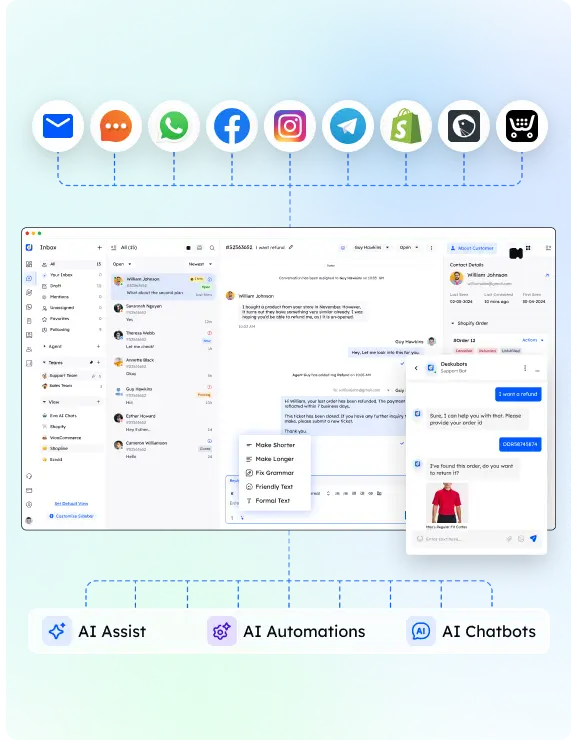When facing customer complaints, respond promptly, empathize, and provide appropriate solutions to resolve issues effectively. Viewing complaints as chances to improve, listen actively, acknowledge emotions, and apologize sincerely. Take responsibility, convey urgency, and show appreciation for feedback.
Engage with open-ended questions and seek clarity with probing questions. Offer personalized solutions, follow up, and demonstrate genuine empathy. Address different customer behaviors with tailored approaches. Empathy in communication can transform negatives into positives, fostering trust and loyalty.
Winning over customers involves empathetic responses and a commitment to enhancing their experience. Show empathy, offer solutions, and turn complaints into opportunities for growth.
How one should respond to your customer complaints?
When responding to customer complaints, promptly acknowledging their feedback and demonstrating a genuine willingness to address their concerns is crucial. Handling complaints effectively is an opportunity to show customers that their satisfaction matters to you.
By asking the right questions and actively listening to their grievances, you can manage their concerns with care and respect. Remember, each complaint is a chance to improve and strengthen your relationship with the customer.
Approach the situation with empathy and understanding, putting yourself in their shoes. By resolving complaints in a timely and considerate manner, you not only address the immediate issue but also showcase your commitment to providing excellent service.
Embrace complaints as a stepping stone towards enhancing your business practices and building customer loyalty.
How to handle customer complaints?
When responding to customer complaints, remember to:
- Listen attentively to their concerns
- Offer a genuine apology
- Ask clarifying questions to fully understand the issue
By showing empathy and actively working towards a solution, you can demonstrate your commitment to resolving the problem and ensuring customer satisfaction.
Checking back with the customer to confirm their contentment with the outcome is essential in maintaining a positive relationship and fostering trust.
1. Listen to the complaint
To effectively respond to customer complaints, prioritize active listening to understand their concerns and demonstrate empathy.
When handling customer complaints, it’s essential to respond promptly and acknowledge their feelings. By actively listening to what the customer is saying, you show that you care about their experience and are dedicated to resolving the issue. Responding promptly also conveys a sense of urgency and importance in addressing their concerns.
Additionally, by acknowledging their feelings, you validate their emotions and show genuine concern for their well-being. This approach helps build rapport with the customer and sets the foundation for a successful resolution.
2. Apologize to the customer
Apologize sincerely to the customer for any inconvenience caused and express appreciation for their feedback.
When addressing customer complaints, a heartfelt apology can go a long way in showing that you value their experience. By acknowledging the issue at hand and taking responsibility, you demonstrate a commitment to resolving the situation.
Showing empathy towards the customer’s feelings lets them know their concerns are heard and understood. Remember, responding promptly with a genuine apology not only shows proactive customer service but also sets the stage for finding a satisfactory resolution.
Approach the apology with a focus on understanding the customer’s perspective and working towards a positive outcome, fostering trust and loyalty in the process.
3. Ask questions
When responding to customer complaints, engage effectively by asking open-ended questions to understand the root of the issue. Encourage customers to share details about their complaint by using probing questions to uncover the underlying cause.
Clarify any uncertainties by asking follow-up questions to guarantee a complete understanding. Request specific examples or details to support their feedback, providing context for resolution.
By asking questions, you demonstrate a genuine interest in resolving the issue and satisfying the customer. Seek feedback on potential solutions by asking for preferences or suggestions to address the complaint effectively.
Engaging in a dialogue through questions not only helps in handling complaints but also shows customers that their concerns are valued.
4. Formulate a solution
After engaging effectively with the customer by asking questions to understand their concerns thoroughly, the next step is to formulate a solution that addresses the complaint promptly and aligns with company policies for effective resolution.
Acknowledge the customer’s feedback promptly and express appreciation for bringing the issue to your attention. Take responsibility for the complaint without making excuses, demonstrating sincerity in resolving the issue. Listen carefully to the customer’s concerns, showing empathy by acknowledging their feelings and expressing genuine concern for their experience.
Offer options for resolving the problem, collaborating with the customer to find a suitable solution that meets their needs while adhering to company policies. By taking these steps, you can effectively address customer complaints and work towards winning them over with excellent service.
5. Check in to see if the customer is happy with the result
Guarantee customer satisfaction by following up to measure their happiness with the resolution of their complaint. After you have worked to resolve the issue, it’s essential to check in with the customer to see if they’re satisfied with the result.
This step in customer service shows your dedication to their experience and allows you to address any remaining concerns promptly. By following up, you demonstrate your commitment to customer satisfaction, building trust and loyalty.
It’s a key part of closing the loop on customer complaints and turning a negative experience into a positive one. Remember, proactive follow-up can go a long way in winning over customers and showing them that their feedback is valued.
6. Clearly outline your plan to remedy the situation
To address customer complaints effectively, clearly outline your plan for resolving the issue by communicating the steps you’ll take and providing a timeline for resolution.
When handling customer complaints, it’s essential to clearly communicate the steps you’ll implement to turn the situation around. Offer personalized solutions tailored to the specific complaint to show attentiveness.
Maintain transparency in your plan to showcase your dedication to resolving the issue and preventing similar complaints in the future. By laying out a detailed plan with a clear timeline, you not only manage customer expectations but also demonstrate your commitment to finding a satisfactory resolution.
7. Thank the customer again and offer follow-up information
Thanking the customer again and offering follow-up information demonstrates your commitment to resolving their complaint thoroughly and ensuring their satisfaction.
Express gratitude for the feedback received and provide additional information or resources to assist further.
Thank the customer for bringing the issue to your attention and offer to follow up to guarantee their expectations are met.
Reassure them that their feedback is valuable and that you’re dedicated to making things right.
By offering to follow up with the customer, you show that you take their concerns seriously and are willing to go the extra mile to address them.
This proactive approach can help rebuild trust and strengthen the relationship with the customer.
Complaint Response Examples
When responding to customer complaints, it’s essential to provide timely and thoughtful solutions.
Acknowledging receipt of the complaint, addressing dissatisfaction, and handling specific scenarios like delivery delays or technical issues are pivotal.
1. Acknowledging Receipt of a Customer Complaint
Upon receiving a customer complaint, promptly acknowledge its receipt to demonstrate responsiveness and care. Express appreciation for the feedback received to show value for the customer’s input.
Avoid making excuses in your response to the complaint to maintain accountability and trust. Take full responsibility for the issue raised to show commitment to resolving it. Apologize sincerely for any inconvenience caused by the customer’s experience to convey empathy and understanding.
2. Responding to Dissatisfaction with Overall Customer Experience
To effectively address dissatisfaction with the overall customer experience, demonstrate genuine empathy and a willingness to find a personalized solution.
When handling customer complaints about their overall experience, it’s essential to listen attentively, acknowledge their concerns, and express empathy for their feelings. Take ownership of the situation and show a commitment to resolving their issues promptly.
Address specific customer concerns by offering personalized solutions tailored to their needs. Following up after implementing the solution is key to ensuring customer satisfaction and nurturing a positive relationship.
3. Handling a Delivery Delay
Addressing a delivery delay promptly demonstrates your responsiveness and concern for the customer’s experience.
When handling customer complaints about a delivery delay, apologize sincerely for any inconvenience caused. Provide a clear explanation for the delay, including factors that contributed to the issue.
Communicate a realistic timeline for when the delivery can be expected, managing customer expectations effectively. To improve customer satisfaction, offer a gesture of goodwill, such as a discount or free shipping.
Showing empathy and understanding towards the customer’s frustration can help turn a negative experience into a positive one. By taking proactive steps to rectify the situation and going the extra mile to make amends, you can win over customers and build long-lasting relationships.
4. Sample Response to a Technical Complaint
Promptly acknowledge the technical complaint to demonstrate your attentiveness and concern for the customer’s issue. Start by apologizing for any inconvenience caused by the technical problem, showing empathy and understanding towards their frustration.
Be clear about the resolution process, explaining the steps being taken to address the technical complaint. Offer alternative solutions or workarounds to minimize customer frustration while the issue is being resolved.
Follow up with the customer after the complaint has been addressed to guarantee their satisfaction and reinforce positive customer relations. By handling the technical complaint with care, transparency, and a focus on resolving the issue efficiently, you can turn a negative experience into a positive one, showcasing your commitment to excellent service.
5. Sample Response to a Shipping Complaint
When managing a shipping complaint, guarantee the customer promptly. Begin by acknowledging the inconvenience caused by the shipping issue. Show empathy towards their frustration to address the customer’s concerns effectively.
Provide a solution or compensation to resolve the shipping complaint swiftly. Guarantee clear communication throughout the process to keep the customer informed.
6. Sample Response to a Social Media Review
To effectively handle a customer’s feedback on social media, start by addressing the customer by name and expressing appreciation for their input.
Acknowledge the negative feedback shared and demonstrate that you grasp the concern raised. Show genuine concern for the customer’s experience and emphasize the significance of their satisfaction.
Apologize sincerely for any inconvenience caused and take responsibility for the situation. Provide a clear solution to resolve the issue and offer steps to address the complaint effectively.
Encourage further communication to guarantee the customer’s needs are met and that they’re content with the resolution. By responding thoughtfully and proactively on social media, you can turn a negative review into a positive outcome and showcase your dedication to excellent customer service.
7. Addressing Technical Complaints
When addressing technical complaints from customers, provide detailed explanations and offer troubleshooting steps to resolve issues effectively.
Start by empathizing with the customer’s frustration and acknowledge the technical difficulties they’re facing. Use clear and concise language to communicate the solutions and guide them through the troubleshooting process.
Make sure that the troubleshooting steps are easy to follow and all-encompassing, addressing the root cause of the technical problem. By showing understanding and offering practical solutions, you can reassure the customer that their concerns are being taken seriously.
Confirm with the customer to verify that the technical complaint has been resolved to their satisfaction, demonstrating your commitment to providing excellent service and winning them over with your support.
Tips for responding to customer complaints
When responding to customer complaints, it is essential to address the issue promptly and show attentiveness. Avoid rushing to provide a solution; take the time to understand the problem and offer viable solutions.
Training your employees to handle complaints effectively, showing empathy, and tailoring responses based on the type of customer you’re dealing with are critical steps in resolving issues and ensuring customer satisfaction.
1. Be proactive
Being proactive in addressing customer complaints can help prevent further issues and establish trust with your customers.
When a customer raises a concern, it’s important to provide proactive responses by acknowledging their feedback in a timely manner. This shows customers that their opinions are valued and you’re committed to resolving any issues they may have.
Offering solutions and options for resolution not only addresses the immediate problem but also demonstrates your dedication to enhancing the customer experience.
By proactively seeking feedback and implementing changes based on complaints, you can elevate your overall service quality and strengthen customer relationships.
2. Avoid rushing a solution
To effectively handle customer complaints, make sure you take the time to thoroughly grasp the issue before hastily offering a solution. Rushing to resolve the problem without fully understanding the customer’s perspective can lead to misunderstandings and dissatisfaction.
Show patience and empathy by listening carefully to their concerns and asking clarifying questions to make certain you have a complete picture of the situation. By demonstrating a willingness to thoroughly listen and comprehend their complaint, you can build trust and rapport with the customer.
3. Train your employees to handle complaints
Guarantee your employees are equipped with the necessary skills to effectively handle customer complaints by providing comprehensive training on active listening, empathy, and collaborative problem-solving techniques. Train them to actively listen without interruptions, empathize with customers by acknowledging feelings, take responsibility for issues, avoid excuses, and provide sincere apologies.
Encourage finding solutions collaboratively with customers to resolve complaints effectively. Empower your team to follow up after resolving complaints to ensure satisfaction and build trust. By instilling these practices in your employees, you can create a customer-centric approach that not only resolves complaints but also strengthens relationships and loyalty.
Providing the right tools and knowledge will enable your staff to handle complaints with professionalism and care.
4. Determine what type of customer youre handling
Identify the type of customer you’re dealing with by evaluating their communication style and behavior patterns. Different types of customers may present varying approaches to expressing their complaints.
Some customers may be emotional, seeking empathy and understanding, while others may be analytical, focusing on facts and details. There are also assertive customers who are direct and proactive in their communication, as well as passive customers who may require more guidance and reassurance.
5. Show empathy
When responding to customer complaints, prioritize showing genuine empathy to improve customer satisfaction and build stronger relationships.
Demonstrating empathy in responses can boost customer satisfaction by up to 70%. Use empathetic language to acknowledge the customer’s feelings, diffusing tense situations and fostering rapport.
Research shows that 65% of customers feel more valued and understood when companies show genuine empathy in handling complaints. Customers are more likely to remain loyal to a company that listens empathetically to their concerns.
Studies indicate that 82% of customers expect empathetic responses when lodging complaints, emphasizing the importance of empathy in customer service.
6. Put yourself in the customers shoes.
To truly understand and effectively address customer complaints, it’s essential to empathize with their perspective and consider the impact of the issue on their experience with your business. Put yourself in the customer’s shoes to acknowledge their frustrations and show genuine empathy.
By understanding their feelings and concerns, you can better tailor a solution that meets their needs. Promptly respond to complaints, taking responsibility for resolving the issue. Avoid making excuses and focus on finding a resolution that aligns with the customer’s preferences.
Demonstrating a commitment to addressing their concerns can help build rapport and win them over with exceptional service. Remember, by addressing complaints with empathy and a focus on solutions, you can turn a negative experience into a positive one.
Conclusion
To sum up, mastering the art of handling customer complaints with empathy, active listening, and a solution-oriented mindset is key to building stronger relationships and enhancing your business reputation.
By addressing concerns sincerely and with care, you can turn negative feedback into positive outcomes and cultivate lasting loyalty among your clientele.
Remember, every complaint is an opportunity to showcase exceptional service and win over customers with your dedication to resolving issues effectively.










